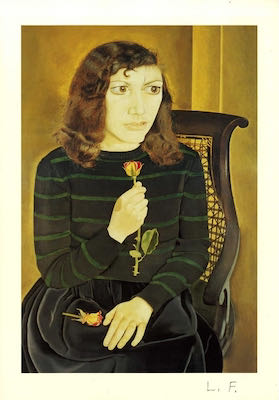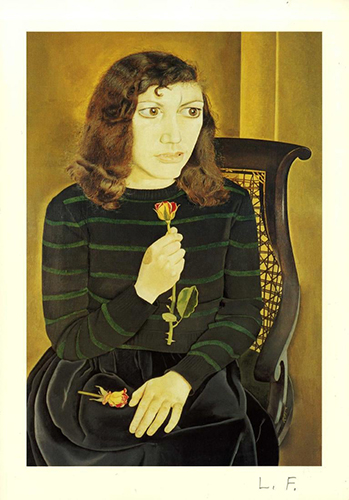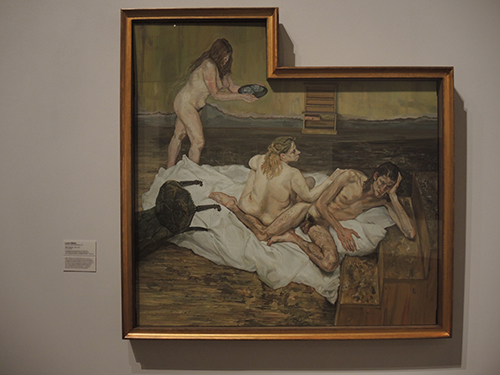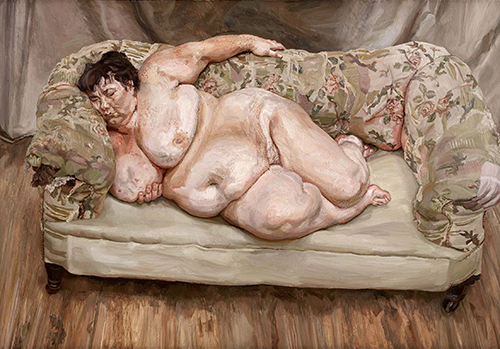
Lucian Freud. Nude reality...
ArtWizard, 02.09.2019
"The subject matter is autobiographical, it's all to do with hope and memory and sensuality and involvement, really."
Lucian Freud
Lucian Michael Freud was a British painter, specialising in Figurative art, and is known as one of the most eminent figurative art painters and portraitists of the twentieth century. He was born in Germany and his father was the grand-son of Sigmund Freud. His family moved to Britain in 1933 and they became British citizens.
In his early life, his art is influenced by the Surrealists, but soon after he starts painting real models and becomes a figurative, very realistic painter. His paintings were made from life models, and the surroundings were often very sombre and in dark places or urban landscapes. His models were usually from his friends and family circles.

Lucian Freud, Girl with Roses, 1947-48
His works are famous with the detailed and even obscene exposure of the human flesh and the artist was even known for asking his models to pose in very extended, even painful positions. His paintings were also developed with very thick impasto, as he had a very particular way of developing them. His paintings required months of observation as he gradually developed them, starting first with s charcoal drawing on the canvas, then painting a small area on the canvas and gradually working outward form this point.
The artist started always with drawing the head of the model, as according to him, this was the way to know more about it and making the connection with the model in this way. His canvases were always impastoed, with rich layers of pigments but part of the canvas was always intentionally left blank, until finishing the whole painting.
His early paintings were mostly of a small scale, and critics say that they have been influenced by Expressionism and Surrealism, although the artist denied fiercely such comparisons. He depicted people, plants and animals in unusual juxtapositions. Some very early works anticipate the varied flesh tones of his mature style, for example the one named Cedric Morris, however after the end of the was the artist developed his linear figurative style with sombre colours. One of the examples of this style is the painting Man with Thistle, as well as a series of portraits of his first wife Kitty, for example a Girl with a Kitten.
These works painted with tiny brushes resembling very much like Dutch style paintings. This is where the transition to his famous Nudes began. Soon after that, the artist developed a much freer style using large hogs-hair brushes, concentrating on the texture and colour of flesh, and much thicker paint, including the impasto technique, such as Girl with a White Dog, where it shows his transition to the plain nude paintings.

Lucian Freud, Girl with aa White Dog, 1950-51
They were done with very precise brush strokes, and Freud cleaned his brush after each stroke when he painted flesh, in order to preserve the colour to remain different with each brush stroke on the painting.
Freud used very much animals in his compositions, and they have been often featuring the pet and his owner. He had a great passion for horses, from the time of his studies in Darlington, where some of his biographers say that he often slept at the stables. Some of his paintings depicting solely horses are Grey Gelding 1985-86 and Skewbald Mare, as well Mare Eating Hay.
Freud's subjects, who needed to make a very large and uncertain commitment of their time, were often the people in his life; friends, family, fellow painters, lovers, children. A page torn out of Lucian Freud’s diary featuring the artist’s sketch of a rat he subdued with sleeping pills and champagne is expected to sell for thousands of pounds when it goes under the hammer next month.
The rough 12cm drawing is a study of Freud’s first ever male nude model, Raymond Jones, complete with the rodent that also appears alongside him in a painting done the same year, called Naked Man with a Rat. Freud agreed to portray Jones, an interior decorator and fixture on the London art scene, in return for Jones lending him money to cover his gambling debts.

Lucian Freud, Naked man with a Rat, 1977
The pair first met when Jones bought a portrait by Freud of George Dyer, the burglar who became artist Francis Bacon’s lover after breaking into his studio. Jones subsequently sat for a series of portraits.
Title of the paintings were in most cases anonymous, and the identity of the sitter not always disclosed; the Duke and Duchess of Devonshire had a portrait of one of Freud's daughters as a baby for several years before he mentioned who the model was. In the 1970s Freud spent 4,000 hours on a series of paintings of his mother.
The artist painted from life models and demanded that the models, were present even when he worked on the basics of the canvas. He spent a great deal of time with his models. He studied them very carefully and was recognised as a perfect “raconteur” of the human mimics. One of his famous nude paintings took on average fifteen months of work and considered finished when, as the artist says “I feel like I am working on someone else’s painting”.

Lucian Freud, After Cezanne, 1999 – 2000
Freud was an addicted gambler and many of his paintings were made of people who lended him money to pay out his gambling depts. Gambling, according to Lucian’s grandfather Sigmund, was merely a substitution for masturbation. Freud did not, however, agree with psychoanalytic interpretations overall, and in this case, the rationale seems unlikely. Once he said that gambling saved him from caring too much about money, in a period where the sales of his paintings were struggling. Gambling offered the artist a counterpoint to the risk of painting in his early years, connection to the outside world. He loved horses and continued to watch races on television and later, as he became increasingly dedicated to art (and less of a gambling man).
Perhaps most surprisingly, Freud’s betting activities won the misanthropic artist—known for his rampant adultery, violent temper, waitress-groping, poor overall behaviour at restaurants, absentee parenting, and paintings of his nude pubescent children—both friends and portrait subjects from diverse social strata. It was simpler, maybe, for him to maintain relationships with people when his debts to them could be measured in pounds and cents.

Lucian Freud, Big Sue, 1995
Freud painted fellow artists, including Frank Auerbach and Francis Bacon and produced a large number of portraits of performance artist Leigh Bower. A series of huge nude portraits from the mid-1990s depicted the very large Sue Tilley or "Big Sue", some using her job title of "Benefits Supervisor" in the title of the painting, as in his 1995 very famous portrait Benefits Supervisor Sleeping, was sold in May 2008 by Christie’s in New York for USD 33.6 million, setting a real record for an auction prices reached by a living artist.
